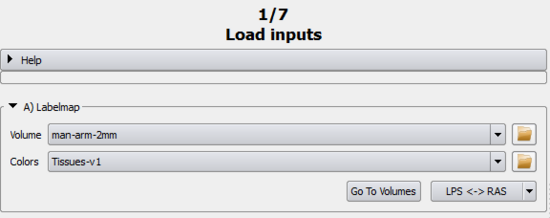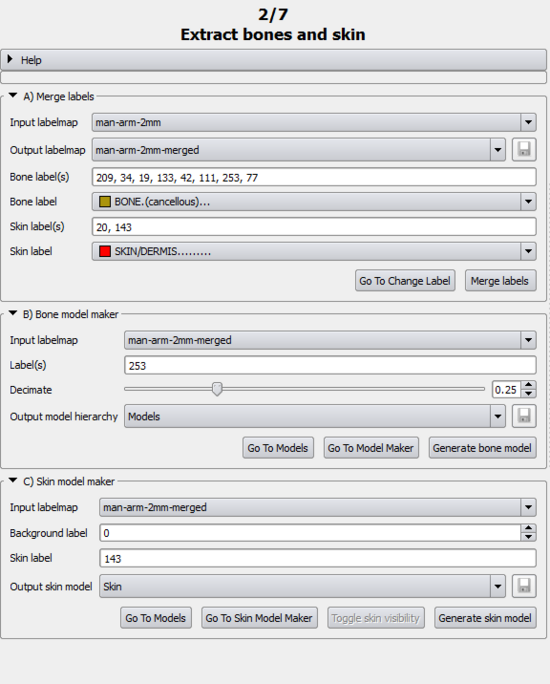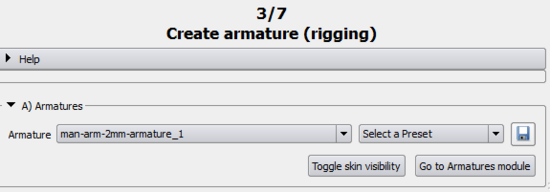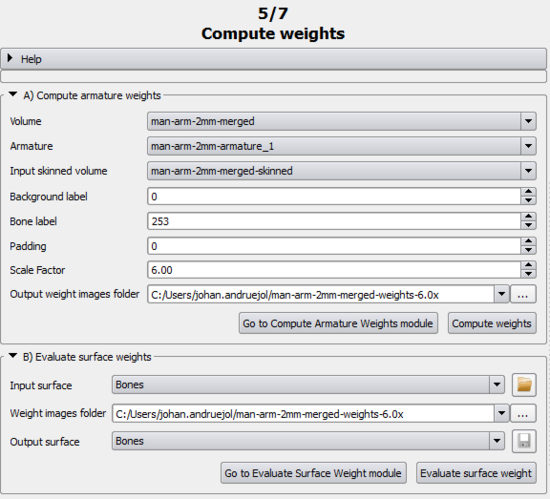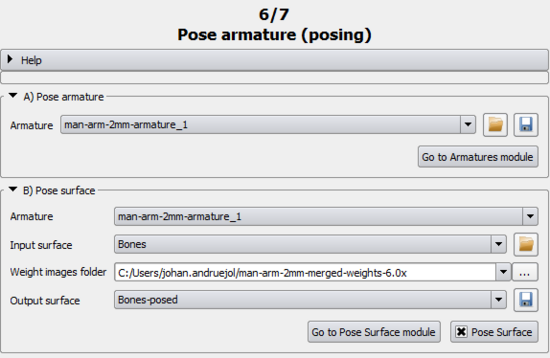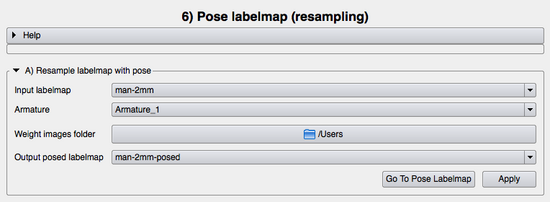Bender/Documentation/1.1/Modules/Workflow: Difference between revisions
(Add Similar Modules section) |
m (Local links should be defined with [[]] and not as external links with []) |
||
| Line 70: | Line 70: | ||
* '''Skin label(s)''': Choose the label(s) that will be merge into the '''Skin Label'''. They are automatically computed based on the input volume color table by looking for names containing "skin" in it. | * '''Skin label(s)''': Choose the label(s) that will be merge into the '''Skin Label'''. They are automatically computed based on the input volume color table by looking for names containing "skin" in it. | ||
* '''Bone label''': Select the new label value of the '''Skin Label(s)'''. | * '''Bone label''': Select the new label value of the '''Skin Label(s)'''. | ||
* '''Go To Change Label''': Opens the [ | * '''Go To Change Label''': Opens the [[Bender/Documentation/1.0/Modules/ChangeLabel|Change Label]] CLI. The [[Bender/Documentation/1.0/Modules/ChangeLabel|Change Label]] CLI allows to change any number of label within a labelmap to a new value. | ||
|[[Image:AdjustPanel-1.0.png|thumb|550px|Adjust labelmap panel]] | |[[Image:AdjustPanel-1.0.png|thumb|550px|Adjust labelmap panel]] | ||
| Line 123: | Line 123: | ||
'''Simple workflow''' | '''Simple workflow''' | ||
* '''Toggle Skin visibility''': Does the same as '''Toggle Skin Visibility''' in ''2) B)''. It is advised to turn off the skin visibility so when placing bone, they automatically will drop at the same depth as the skeleton model instead of the skin model. | * '''Toggle Skin visibility''': Does the same as '''Toggle Skin Visibility''' in ''2) B)''. It is advised to turn off the skin visibility so when placing bone, they automatically will drop at the same depth as the skeleton model instead of the skin model. | ||
* '''Load armature from model''': Prompts a dialog window to open an armature from a model. See [ | * '''Load armature from model''': Prompts a dialog window to open an armature from a model. See [[Bender/Documentation/1.0/Modules/Armatures|Armatures]] module for further details. | ||
* '''Go To Armature Module''': Opens the [ | * '''Go To Armature Module''': Opens the [[Bender/Documentation/1.0/Modules/Armatures|Armatures]] module.[[Bender/Documentation/1.0/Modules/Armatures|Armatures]] module allows the user to modify the armature by adding, tweaking, deleting bones in Rest mode. The display properties of the armature like X-Ray mode, opacity, color or shape can also be modified there. | ||
| align="right"| | | align="right"| | ||
| Line 146: | Line 146: | ||
* '''Skin volume''': Compute the skinned volume. The output skinned volume is a labelmap where each voxel of the input '''Volume''' is associated with a bone of the input '''Armature'''. This means that if we were to use binary weights, a given voxel will move exactly as its associated bone in the skinned volume. For this reason and as the skinned volume drives the weight computation, it can be very profitable to tweak this results, most notably in joints area. | * '''Skin volume''': Compute the skinned volume. The output skinned volume is a labelmap where each voxel of the input '''Volume''' is associated with a bone of the input '''Armature'''. This means that if we were to use binary weights, a given voxel will move exactly as its associated bone in the skinned volume. For this reason and as the skinned volume drives the weight computation, it can be very profitable to tweak this results, most notably in joints area. | ||
'''Advanced workflow''' | '''Advanced workflow''' | ||
* '''Go To Volume Skinning Module''': Opens the [ | * '''Go To Volume Skinning Module''': Opens the [[Bender/Documentation/1.0/Modules/VolumeSkinning|Volume Skinning]] module. | ||
===B) Compute armature weight=== | ===B) Compute armature weight=== | ||
| Line 159: | Line 159: | ||
* '''Armature''': Select the armature associated with the '''Volume'''. It should be the that was used for the ''A) Volume Skinning''. | * '''Armature''': Select the armature associated with the '''Volume'''. It should be the that was used for the ''A) Volume Skinning''. | ||
* '''Input skinned volume''': Select the skinned volume. It should be the (possibly tweaked) volume associated with the '''Volume''' and the '''Armature'''. | * '''Input skinned volume''': Select the skinned volume. It should be the (possibly tweaked) volume associated with the '''Volume''' and the '''Armature'''. | ||
* '''Go To Compute Armature Weights Module''': Opens the [ | * '''Go To Compute Armature Weights Module''': Opens the [[Bender/Documentation/1.0/Modules/ComputeArmatureWeight|Compute Armature Weight]] module. In the [[Bender/Documentation/1.0/Modules/ComputeArmatureWeight|Compute Armature Weight]] module, the user can further refine the computation of the weight by, for example, restricting it to a given bone or the downsampling factor. | ||
| align="right"| | | align="right"| | ||
| Line 182: | Line 182: | ||
* '''Input surface''': Select the input surface that will have the weight evaluated on. | * '''Input surface''': Select the input surface that will have the weight evaluated on. | ||
* '''Weight images folder''': Select the folder where the weight images are. | * '''Weight images folder''': Select the folder where the weight images are. | ||
* '''Go To Evaluate Surface Weight Module''': Opens the [ | * '''Go To Evaluate Surface Weight Module''': Opens the [[Bender/Documentation/1.0/Modules/EvalWeight|Evaluate Weight]] module. | ||
===B) Armatures=== | ===B) Armatures=== | ||
| Line 189: | Line 189: | ||
'''Simple workflow''' | '''Simple workflow''' | ||
* '''Go Armature Module''': Opens the [ | * '''Go Armature Module''': Opens the [[Bender/Documentation/1.0/Modules/Armatures|Armatures]] module. In that case, the [[Bender/Documentation/1.0/Modules/Armatures|Armatures]] module can be used to reset the current pose to its originals rest value. This can be useful in order to create a clean pose. | ||
===C) Pose surface=== | ===C) Pose surface=== | ||
| Line 202: | Line 202: | ||
* '''Input surface''': Select the input surface that will be posed. | * '''Input surface''': Select the input surface that will be posed. | ||
* '''Weight images folder''': Select the folder where the weight images are. | * '''Weight images folder''': Select the folder where the weight images are. | ||
* '''Go To Pose Surface Module''': Opens the [ | * '''Go To Pose Surface Module''': Opens the [[Bender/Documentation/1.0/Modules/PoseSurface|Pose Surface]] module. | ||
| align="right"| | | align="right"| | ||
| Line 225: | Line 225: | ||
* '''Input surface''': Select the input labelmap that will be posed. | * '''Input surface''': Select the input labelmap that will be posed. | ||
* '''Weight images folder''': Select the folder where the weight images are. | * '''Weight images folder''': Select the folder where the weight images are. | ||
* '''Go To Pose Labelmap Module''': Opens the [ | * '''Go To Pose Labelmap Module''': Opens the [[Bender/Documentation/1.0/Modules/PoseLabelmap|Pose Labelmap]] module. It can be useful to tweak some of the parameters like the Maximum radius to prevent the computation to take too much time. | ||
| align="right"| | | align="right"| | ||
Revision as of 23:30, 26 March 2013
Introduction
This module guides the user step-by-step into transforming a volume using a rigging, skinning and posing technique.
Details
Author: Julien Finet, Kitware
Contributor #1: Johan Andruejol, Kitware
Acknowledgements: This work is supported by the Air Force Research Laboratories.
Contact: Julien Finet
Use Cases
Parameters
Advanced properties
The Advanced properties can be shown/hidden by clicking on the expanding button.
Volume renderAt anytime, the Volume render helps to visualize, inspect a volume/labelmap.
|
1) Adjust labelmap
The Adjust labelmap is the first step of the Bender workflow where the user can tweak the labelmap that will be posed before any kind of computation is done.
A) LabelmapThis section helps to make sure the input labelmap has the right color table associated with it and is in the right coordinates. Simple workflow
Advanced workflow
B) Merge labelsThis section provides the functionality of merging the bones labels and the skin label of the input labelmap to ease the visualization/usability of the bones and the skin that often have different labels in the input 'raw' labelmap. Simple workflow
Advanced workflow
|
2) Extract bone and skin
The 2) Extract bone and skin page deals with creating the bone and skin model that will serve as references and watch dogs for the posing.
A) Bone model makerThis helps to create the bone model. Simple workflow
Advanced workflow
B) Skin model makerThis section is in charge of creating the skin model. Simple workflow
Advanced workflow
|
3) Create armature (rigging)
Note: When opening this page, the view will automatically switch to 3D Only to help creating/visualizing the armature.
A) ArmaturesThe armature (either created or loaded) is the interface between the user and the transformations needed to pose the volume models. Once completed, the armature rest positions should not be changed since it would necessitate all the following computation to be updated as well. It is therefore highly encouraged to save the created armature in order to be able to restore it with Load armature from model. Simple workflow
|
4) Compute weights (skinning)
The Compute weights section is where each voxel of the input image gets attributed a weight that represents by how much it is influence by a given bone movement.
Note: When opening this page, the view will automatically switch to Four Up.
A) Volume skinningTo compute a weight, the skinning volume must first be computed. The skinning represents what bones influences the most a given voxel. Simple workflow
Advanced workflow
B) Compute armature weightThe weight computation is then refined further in order to consider the influence of every bone on a given voxel. Simple workflow
Advanced workflow
|
5) Pose armature (posing)
This page is meant to help the user to find the right pose before starting the 6) Pose labelmap by posing a model interactively.
Note: When opening this page, the current armature (if any) will automatically switch to Pose mode.
A) Evaluate surface weightThe first step is to evaluate the weight at each vertices of the model using A) Evaluate surface weight. Simple workflow
Advanced workflow
B) ArmaturesThis just serves as a quick link to the Armature module, should it be needed. Simple workflow
C) Pose surfaceThis poses any surface according to the armature. Usualy, the skin and bone models give a fairly good idea of what the result of the 6) Pose labelmap will look like. Simple workflow
Advanced workflow
|
6) Pose labelmap
Final step of the workflow, the 6) Pose labelmap uses the posed armature and the weights associated with it to compute the posed labelmap.
A) Resample labelmap with posePose a labelmap given an armature and the weights associated with it. Simple workflow
Advanced workflow
|
Similar Modules
- Used modules
- Bender modules: Armatures, Change Label, Compute Armature Weight, Pose Surface, Pose Labelmap, Volume Skinning
- Slicer modules: Grayscale Model Maker, Models, Models Maker, Volumes, Volume Rendering







